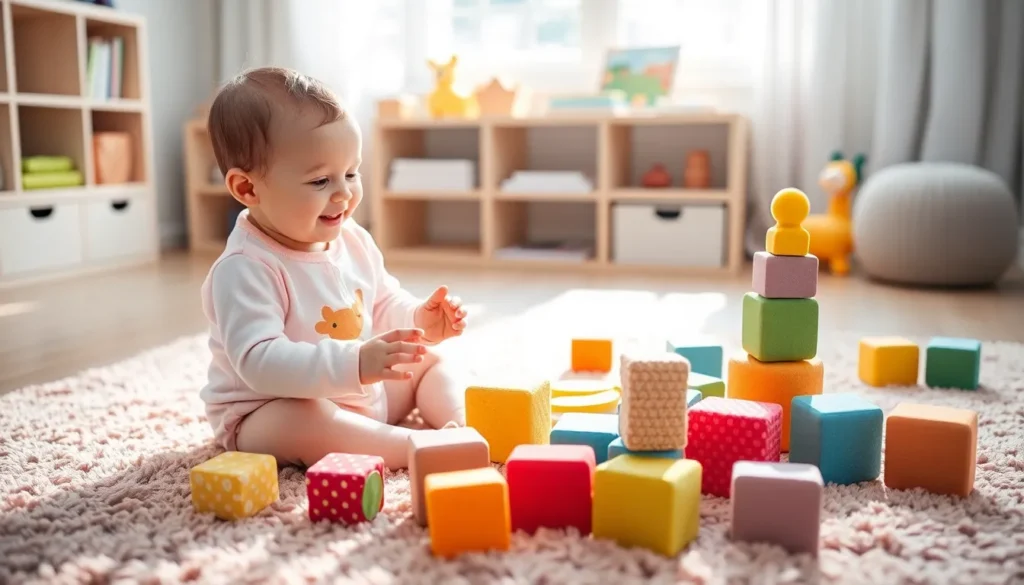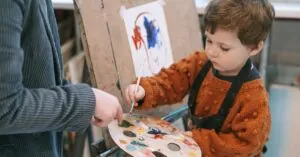Table of Contents
ToggleWhen it comes to baby toys, soft blocks might just take the cake. They’re squishy, safe, and tossing them around makes even the tiniest of humans feel like towering giants. If every parent had a dollar for every time their baby gleefully launched a block across the room, well, let’s just say, they could buy a lifetime supply of them. In this guide, we’ll jump into all things soft blocks, from what they are to how they can spark creativity and safe play in your little one’s day. Get ready to turn your playroom into a delightful block party.
What Are Soft Blocks?

Soft blocks are plush, lightweight, and typically made of fabric or foam materials. Unlike their hard counterparts, these blocks are designed with your baby’s safety in mind. They come in various shapes, sizes, and colors, which can capture an infant’s attention and inspire curiosity. Whether they’re tossing them, stacking them, or any baby-sized engineering feats in between, soft blocks provide a world of tactile exploration.
These blocks are often filled with air or soft materials to ensure they are cushioned and safe for play. Most soft blocks are machine washable, making cleanup a breeze. With designs that often include textures and sounds, they invite endless hours of exploration, stimulating your baby’s sense of touch and auditory senses.
Benefits of Soft Blocks For Infants
Soft blocks offer a multitude of benefits that go beyond mere entertainment. First off, they aid in fine motor skill development. As babies stack, grasp, and manipulate blocks, they enhance dexterity and hand-eye coordination. Ever watch a baby stack three blocks and then demolish them? That’s engineering at its finest.
Also, these blocks also support cognitive development. Babies learn about cause and effect when they drop a block and watch it tumble to the ground. This simple action lays the foundation for future understanding of physics concepts.
Let’s not forget social and emotional benefits. Soft blocks come into play during group activities. Kids learn how to share, cooperate, and take turns. Plus, there’s nothing quite like the infectious laughter that erupts when a block tower tumbles, making blocks fantastic for fostering social interactions.
Choosing the Right Soft Blocks
Selecting the right soft blocks can feel like a monumental task, but it doesn’t have to be a stress fest. First, look for blocks that are age-appropriate. For infants under six months, consider lightweight, smaller blocks that they can easily grasp. As they grow, they can handle larger, more complex shapes.
Check the materials used. Opt for non-toxic, BPA-free products that are safe for munching and chewing. After all, exploratory bites are bound to happen. You’ll also want to ensure they are durable and withstand those enthusiastic tosses and gnaws.
Finally, consider the design. Bright colors and varied textures can intrigue your little one and keep them engaged for longer periods. Look for blocks that offer multisensory experiences, such as rattles or crinkly sounds, to keep the excitement alive.
Types of Soft Blocks
The world of soft blocks is vast, and you may find several types that cater to different developmental needs. Here’s a quick breakdown:
Basic Soft Blocks
These are the classic designs you’ll often see, usually squares or rectangles, perfect for squishing and stacking. They may feature different colors, patterns, and textures to enhance sensory engagement.
Textured Blocks
Infused with surfaces that vary in feel, textured blocks add another layer of exploration. From bumpy to ridged, your baby can discover a feast for their fingertips.
Sound-Enabled Blocks
Add a bit of auditory joy with blocks that crinkle, jingle, or rattle. These sounds keep babies entertained and help them make associations between actions and sounds.
Interactive Blocks
Some soft blocks come with interactive features, like buttons or mirrors. These encourage babies to explore even further and often boost cognitive development with play-based learning activities.
Playing Safely with Soft Blocks
Safety should always remain a top priority during playtime. Here are some tips to ensure a safe and enjoyable experience:
- Clear a Playing Area: Make sure the play area is free from hard objects or sharp corners that could pose risks when blocks inevitably go airborne.
- Supervise Playtime: Always watch your baby while they play. Close supervision prevents any potential mishaps and ensures they’re having fun in a safe environment.
- Check for Wear and Tear: Regularly inspect blocks for any signs of damage, like tears or loose parts. Replace any that aren’t in pristine condition.
Creative Play Ideas with Soft Blocks
Soft blocks are a blank canvas for imaginative play. Here are some creative ideas to enhance your baby’s experience:
- Building Towers: Encourage them to stack blocks and see how high they can go. Making towers can promote spatial awareness and motor skills.
- Color Sorting Games: Use the blocks to teach colors. Ask your baby to sort blocks by color, turning playtime into an educational activity.
- Obstacle Courses: Use blocks to create an obstacle course. Your baby can crawl, climb, or navigate through or around the blocks.
- Block Art: Use fabric-safe markers to decorate the blocks. Create seasonal themes or simple shapes, just ensure the inks are baby-safe.




